First Impressions
The Sony A95L 4K TV is shaping up to be one of the best TVs of the year with its impressively natural picture performance, slick user experience, and impactful audio for a flatscreen TV.
Availability
- UKRRP: £3699
- USARRP: $3499
- EuropeTBC
- CanadaTBC
- AustraliaTBC
Introduction
With Sony’s 2023 TV line-up now available to purchase, there’s just one holdout we’re waiting for – the flagship A95L that’s the final piece of the brand’s line-up.
I’ve previously written about how much I’m looking forward to this model after reviewing the A95K, a TV that was very good – excellent in some ways – but just shy of being the outright best. Having had a closer look at the A95L it feels a step on Sony’s already impressive QD-OLED debut.
Here some more thoughts on the Sony A95L ahead of its launch.
Design
- New stand design
- Slimmer looking design
- Comes with the Bravia Cam
Instead of the integrated stand that acted as a counterweight to keep the TV upright that featured on the A95K, Sony has (thankfully) abandoned that concept for blade feet instead.
These feet can be positioned in one of three ways: towards the edges, in a narrow position (for smaller furniture) or to prop up the screen and place a soundbar in below. It’s so obvious a change in terms of convenience, I wonder why Sony didn’t go down this route with the A95K.
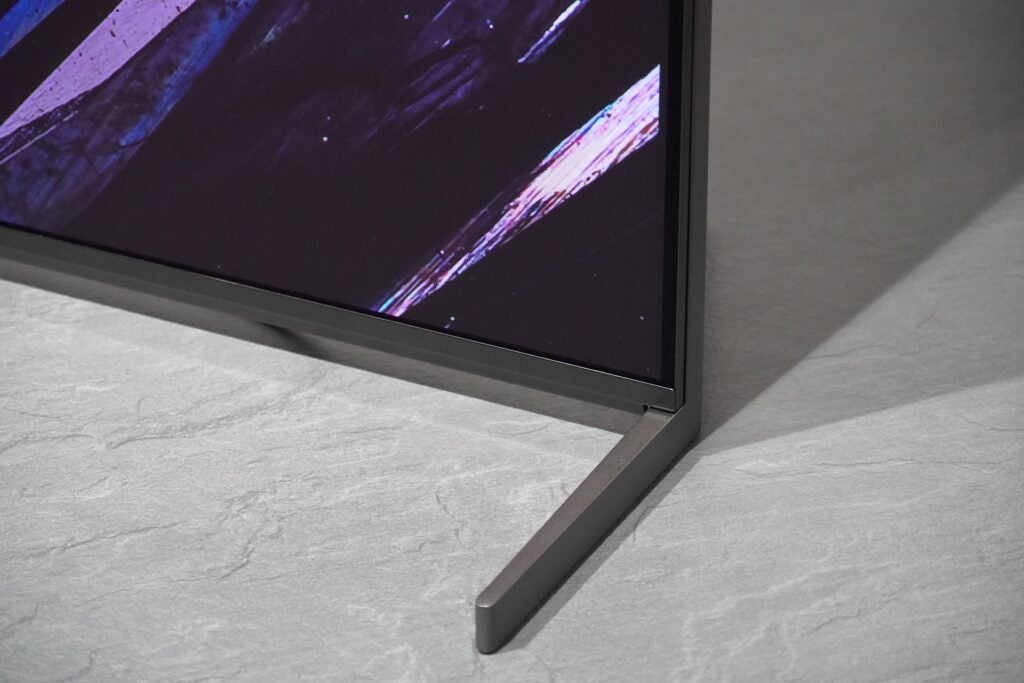
Regardless, that misstep is now consigned to the past. Nevertheless, the A95L’s design retains many of the characteristics that have become Sony’s stock in trade. The design features a minimalist aluminium bezel to ensure the screen hogs your attention. When in its ‘One Slate’ orientation (feet out towards the edges) it takes on a massive, all-encompassing, room-dominating feel.
Sorplas is Sony’s “unique” material that it uses for the rear panel of the A95L, which it says reduces the use of virgin plastic in the construction of the TV. The packaging will be look different too: plastic materials reduced by 35%, the box itself reduced in size by 15% and ink usage by 90% as Sony continues down the Road to Zero.
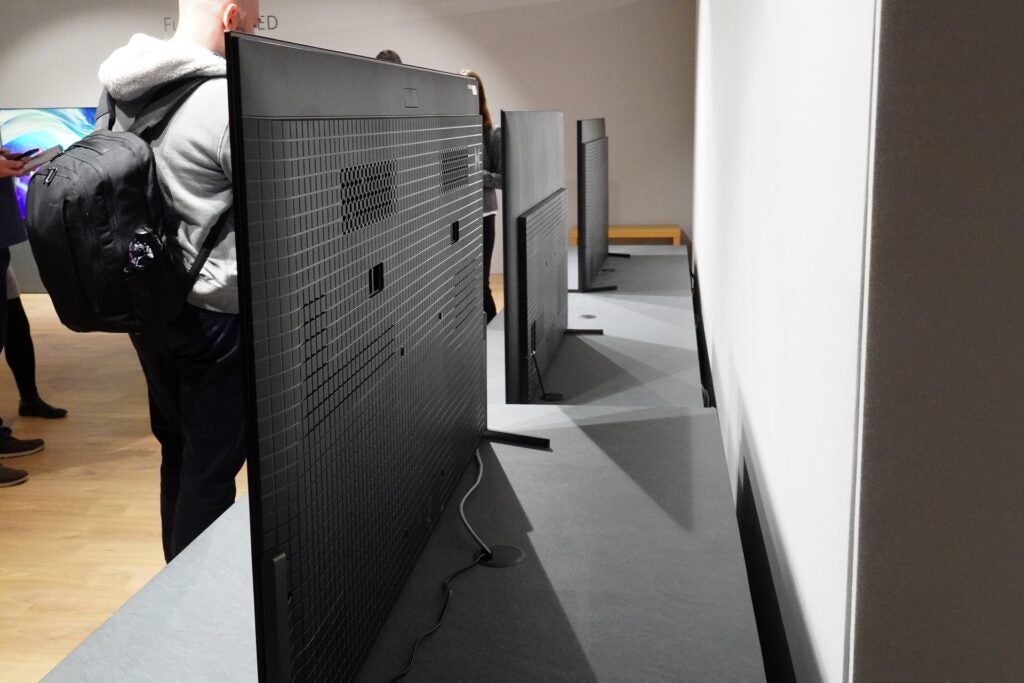
With the 77-inch model the feet can only be arranged in the centre. Otherwise, there are a few changes to the rear of the screen as it doesn’t jut out as much as previous Sony OLEDs, looking slimmer and more discreet. This trimmed down aesthetic will benefit those looking to wall-mount the set given it’ll sit closer to the surface.
The screen yet again features a heat diffusion sink to manage and distribute energy and heat more efficiently and avoid screen burn-in that affects OLED panels. The A95L will also be packaged with the BRAVIA Cam to plonk on top of the screen.
There’s a new backlit remote with an aluminium finish that if memory serves is a little smaller than before. There are new menu keys, a key for Google Dashboard, and an app key for direct access to the Crunchyroll streaming service (which Sony owns) if you’re an anime fan. A more conventional remote is packaged with the TV too.
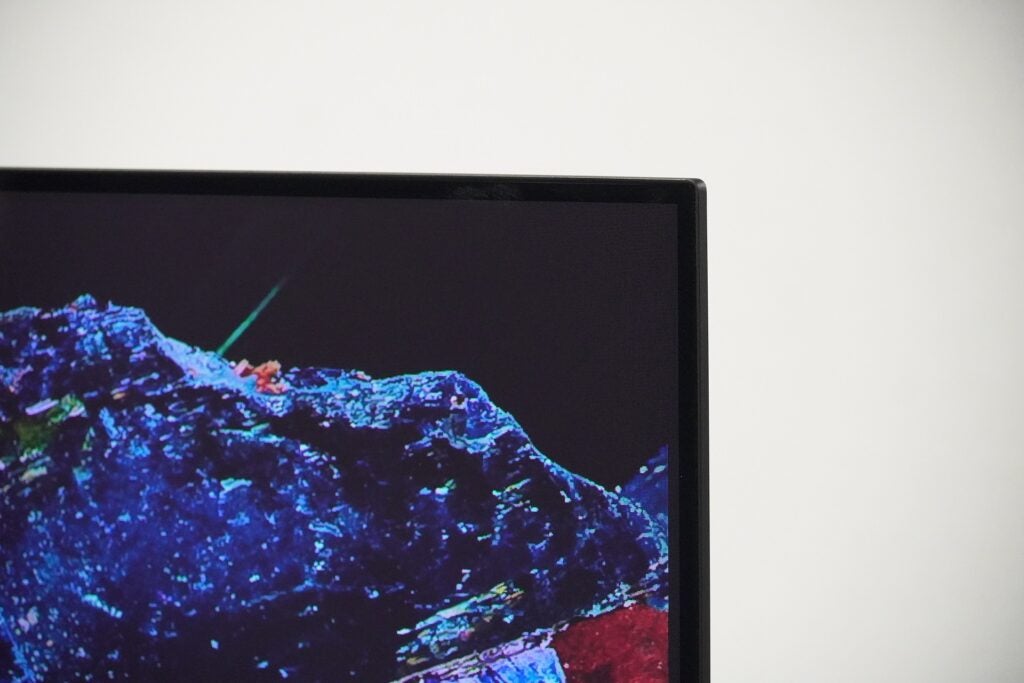
Features
- Adds Dolby Vision Gaming support
- New Game Menu for adjusting settings
- New Eco Dashboard for managing energy use
Features mostly cover the same ground as the 2023 range, though the A95L will be getting a few exclusives that aren’t available on other Sony TVs.
One such exclusive feature is Dolby Vision Gaming which will optimise contrast, black levels and colour performance with supported games. That will be arriving in a future update within the calendar year (although Sony and promised firmware updates aren’t exactly bedfellows). The PS5 as of yet doesn’t support this HDR feature, so I’d find it a bit odd if the A95L included a feature the PS5 wasn’t capable of showcasing…
4K/120 is included on the spec sheet as are the ‘Perfect for PlayStation 5’ features, which refers to the (useful) Auto HDR Tone Mapping to produce a more accurate HDR picture and Auto Genre Picture Mode, which is Sony’s fancy way of describing auto low latency mode for its TVs that automatically switches to and from game modes when the TV recognises you’re playing a game and not watch iPlayer, for instance.
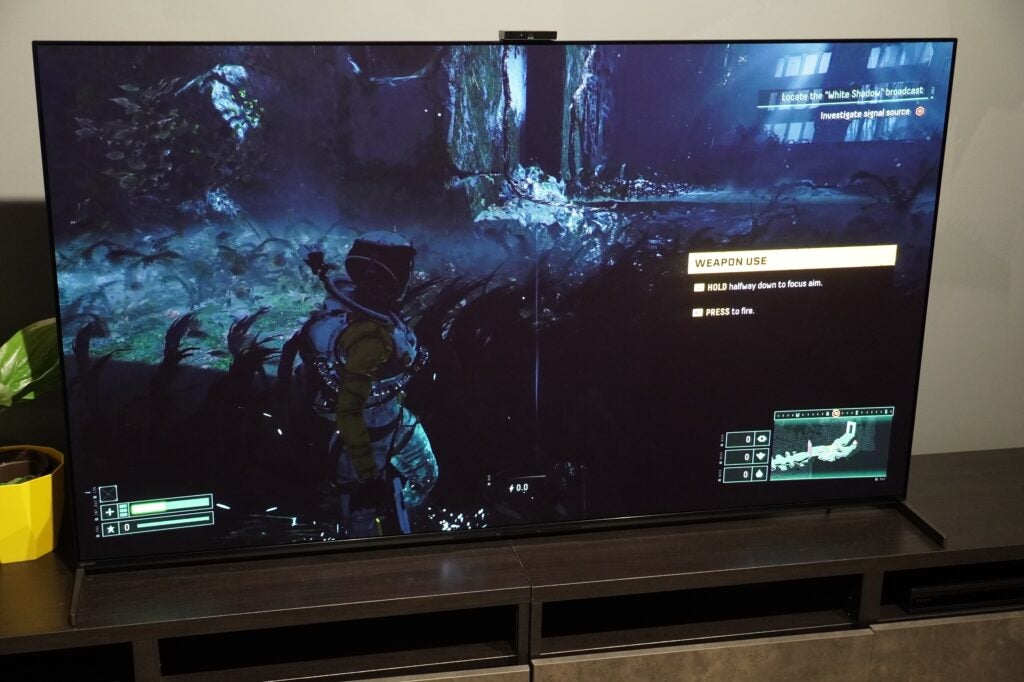
More exclusive gaming features arrive in the PS Remote Play feature that was revealed in September 2023 (app is currently available on Android). This provides remote gameplay with the PS5 (or PS4) console regardless of where you are. You could, for instance, be upstairs; or could be at your work office and the console is at home – you don’t have to be on the same Wi-Fi network.
Having been shown a demonstration of the A95L and a PS5 on the same network (playing Returnal) the lag seemed low, if barely noticeable at all, and visually the game looked very good. Not the sharpest image – there’s no 4K support, but it should be able to do 2K resolution at 60 frames per second. This isn’t a feature you’d necessarily use for a very responsive game or one that invokes fast twitch reactions like a first-person shooter.
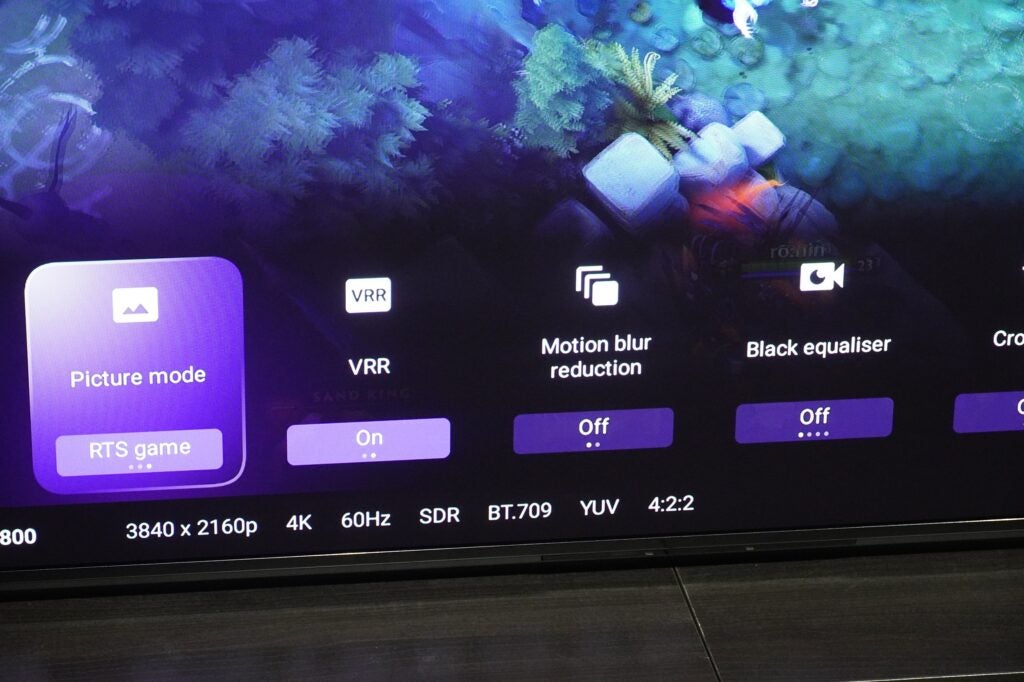
Game Menu sees Sony taking a leaf out of other TV manufacturer’s playbooks and making it easier to change game settings on the fly. There are specific modes to choose from to enhance the performance of first-person shooter or real time strategy games (to give an example of two), and depending on the mode, it’ll improve the brightness/adjust the gamma to give you a peak into those rich black levels and spot an enemy. I feel like that’s cheating a little bit…
The interface is Google TV for getting entertainment from streaming apps as well as personalising the whole curation process to keep you watching more and more. All the UK catch-up apps are included, but it’s more the mobile connectivity that’s key here, with the ability to add a title to your library on your Android phone and have it waiting for you when you return home. It’s not just the personalised recommendations, but also the synching between devices.
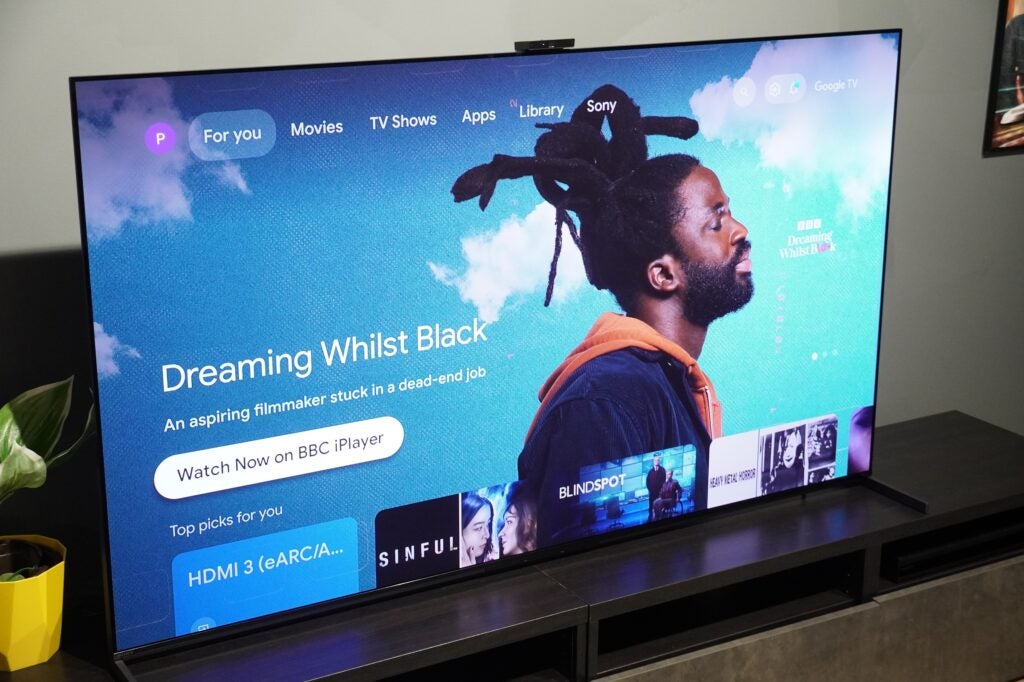
There’s another exclusive feature here with the new menu system. To me it looks similar to the one that already exists, but this new version has a more fluid look and bigger icons that get embiggened as you hover over them. It can be edited to add the features you want for quick access such as audio settings, ambient optimisation, picture settings, expert panel settings etc. This is all part of a new platform Sony is bringing to its TVs, with the A95L being the first to batter up.
There are only two HDMI 2.1 inputs, so although it doesn’t have the new MediaTek chip, the chip it has is more advanced than the A80L as it supports Dolby Vision Gaming. Dolby Vision HDR (for films and TV), IMAX Enhanced (which is compatible with BRAVIA Core) and Netflix Adaptive Calibrated mode return in terms of picture modes.
BRAVIA Core offers 5, 10 or 15 credits to redeem movies purchases (you can pay for more), and up to 24 months of streaming. It’s effectively a store and streaming service put together but requires at least 80Mbits connection to get things going.
Sony is also placing more of an emphasis on customers being aware about their energy consumption. The Eco Dashboard presents a picture of a tree, and as you change settings to reduce energy, the tree gets bigger. It’s on all of Sony’s 2023 TVs, including the midrange A80L.
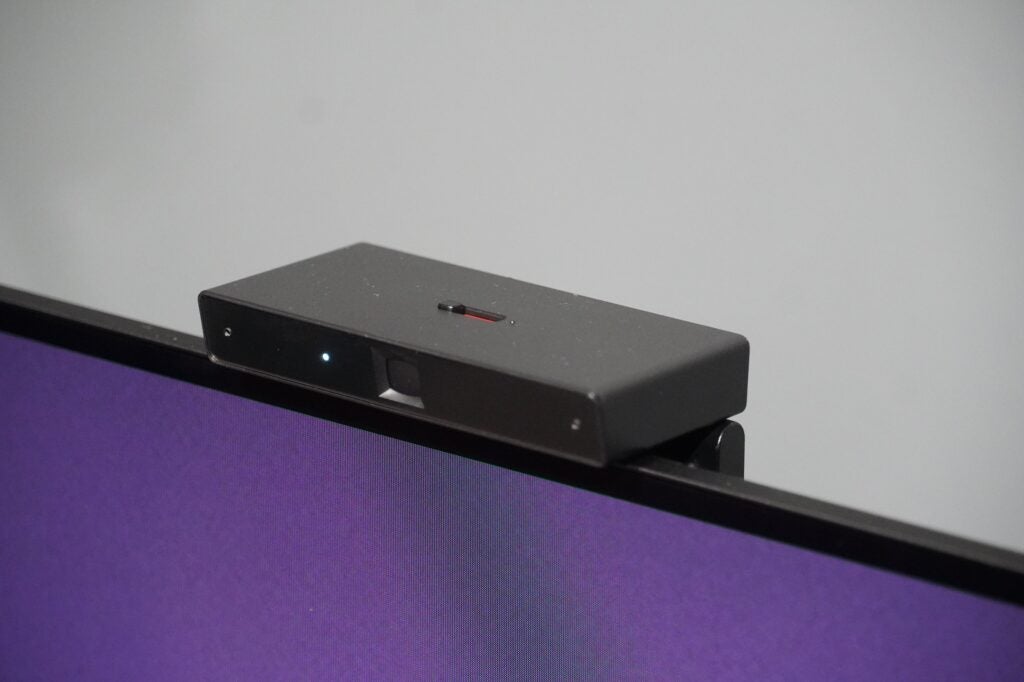
The BRAVIA Cam can help in reducing energy consumption, too. Most will think the camera is primarily for video conferencing calls, but like Sky Live it has multiple uses. It’ll assist the Ambient Optimization Pro feature to tweak the picture for where you’re sitting (it’ll also angle the sound output as well); and there’s other features such as gesture control, proximity alert (for any wandering toddlers) and the power saving mode whereby the camera will be able to detect whether you’ve left the room and it’ll dim the screen’s brightness.
Picture Quality
- Brighter, more detailed picture
- Naturalistic image
- Impressive upscaling
The A95L I was demoed was closer to the final version that’s about to launch in stores and online, and unlike the previous time I saw the TV, I was allowed to take pictures.
The A95L sat alongside a Samsung S95C QD-OLED and LG G3 OLED, and the results between the three were interesting. It was first shown in its Vivid mode, which sees the TV’s brightness and general performance turned up to the max. Like the Philips OLED+908, the Sony takes a more natural view to handling its Vivid mode. It’s no lurid, eye-grabbing colours that the LG, and to a greater extent, the Samsung are guilty of; but it is more amped up.
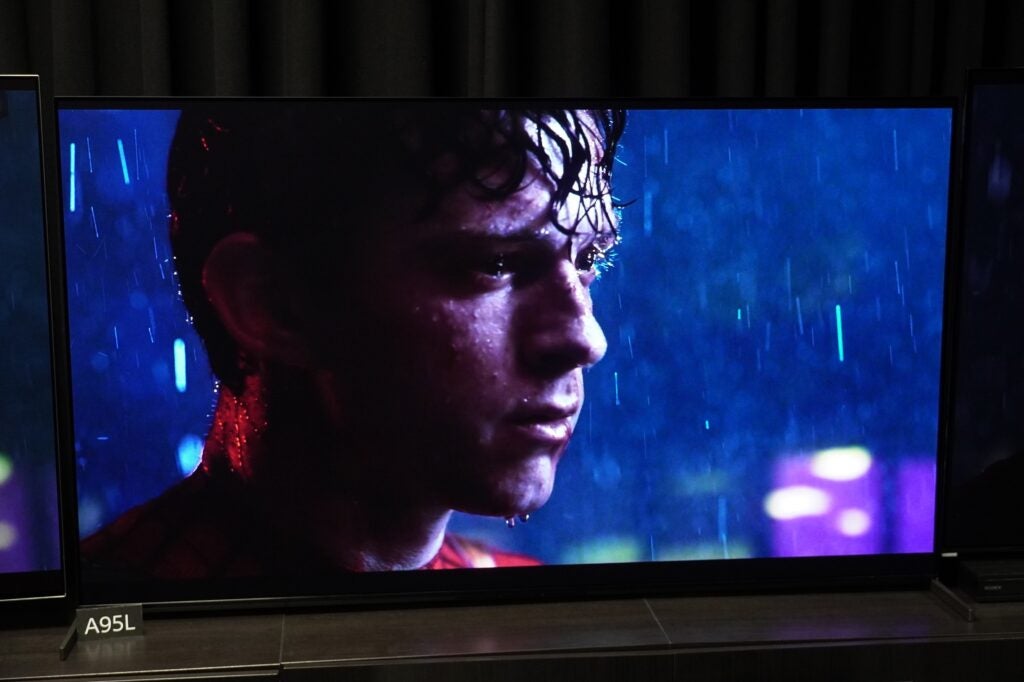
Reds, blues, and purples are juiced up in a film such as No Way Home, but it still feels in-keeping with the overall look of the cinematography: vibrant, with more contrast and punch.
And like the upcoming Philips model, the Sony’s XR Cognitive Processor retains a lot more detail in the demo shots of a wedding dress that I saw, the fine textures patterns are much more visible than they are on the LG, which applies too much brightness to scene and masks those details. Again, this is Vivid mode, but it’s a sign that you’ll get a representative performance in this mode rather than an overcooked one.
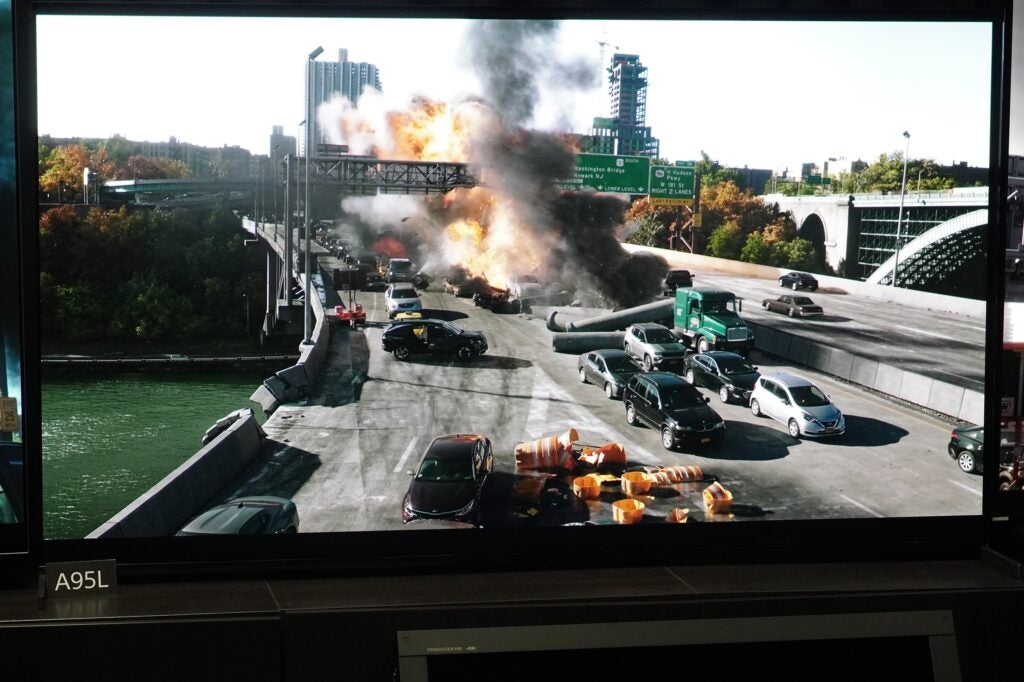
Sony claims the A95L is twice as bright as the A95K – as usual Sony weren’t given to comment on how bright it is in figures – with the improvements to its wider colour gamut performance. Indeed, compared to the Samsung S95C, the Sony has a much more natural (that word again) way with colours, but also in terms of detail and sharpness. A scene from The Northman and the S95C looked overly sharp, colours looked cold, flat and muted (even in its Standard mode).
A clip of Harry Potter (seemingly DVD resolution) and the LG was overly bright to the point where it looked as if there was a light source that shouldn’t be there – the scene being Voldemort and his followers outside Hogwarts before the final battle. Noise reduction was smoother, less distracting on the Sony than either of the other two models.
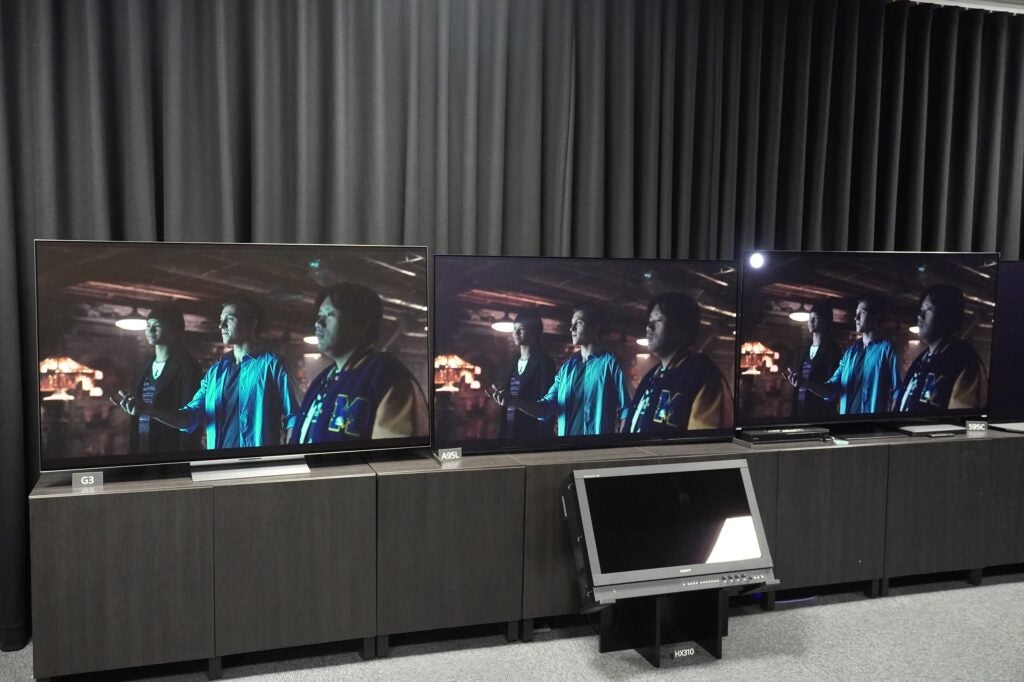
The LG also looked a little green in places, something I’ve mentioned before. Sony’s intent with A95L is to respect the Filmmaker’s intent and, for sure, out of the three TVs, the A95L was closer the mastering monitor than the LG and Samsung. Sony’s renamed is Custom mode Professional for this year (it doesn’t support Filmmaker mode), and even its Standard picture mode is taking more cues from being closer to the mastering monitor. Accuracy is a big focus for the Sony A95L, and from this hands-on experience, Sony is well on its way to achieving that.
Sound Quality
- Dolby Atmos
- Tweaked Acoustic Surface Audio system
- 360 Reality Audio support
As usual there’s Dolby Atmos support through the Acoustic Surface Audio sound system that uses actuators to vibrate the screen and produce sound. With the A95L it’s the same configuration as before – two actuators and two subwoofers – but Sony says they’ve improved the hardware and software, with new digital filters to improve clarity and positioning of effects.
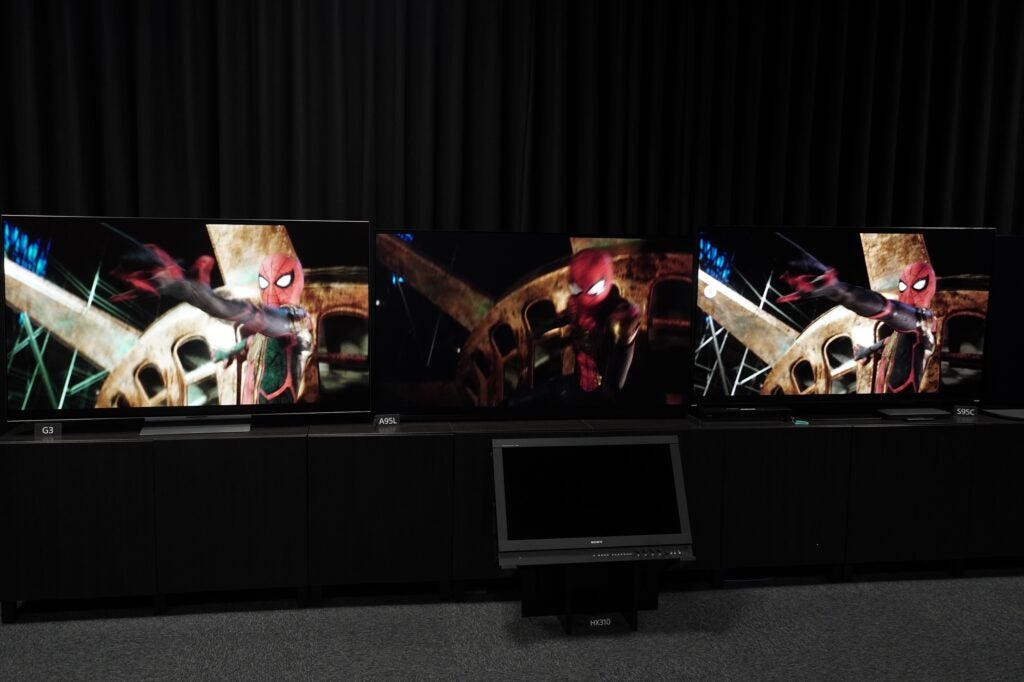
There’s also less distortion at higher volumes, something that I found become an issue with the A95K over the course of reviewing it. Listening to all three TVs, the Sony was easily the most powerful, sharp, and dynamic listen.
And with Acoustic Center Sync the A95L can synchronise its speakers with supported Sony soundbars to produce a clearer, detailed centre channel to assist with dialogue. Sony’s 360 Reality Audio can produce a hemisphere of sound with the A95L at the centre of it – partnered with a soundbar such as the HT-A7000, subwoofer and surround sound system, the height effect, clarity, and placement of effects is quite impressive to hear.
For a personal listening experience, you could connect a pair of Sony headphones (what else!) to the TV, if you don’t want to disturb others in the house.
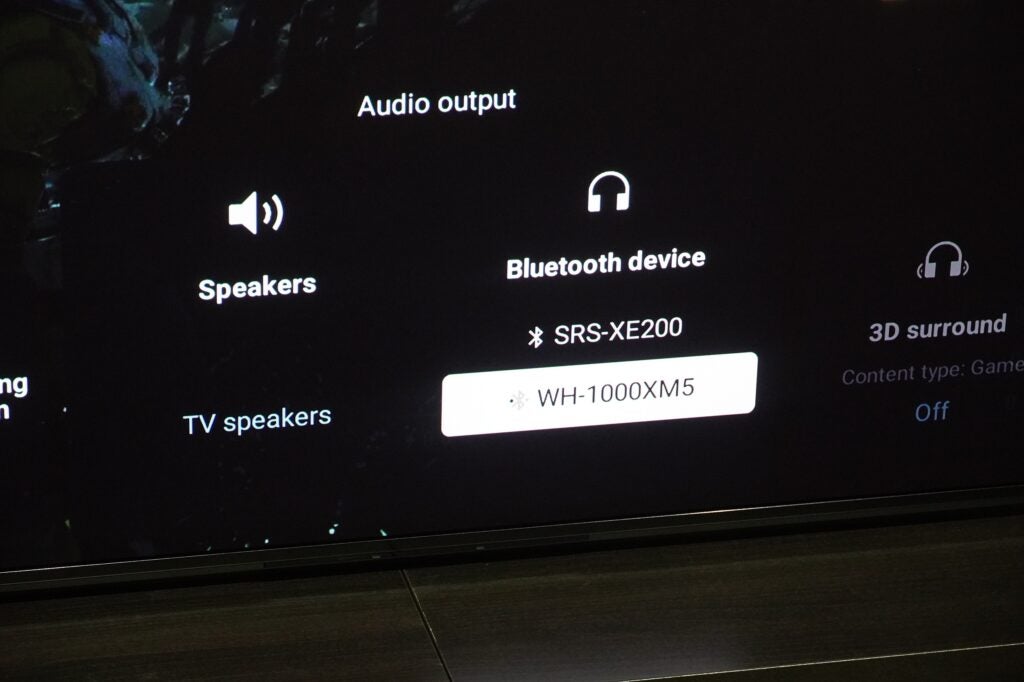
First impressions
When I first saw the Sony A95L it looked promising. Upon a second closer look, the A95L is shaping up to be one of the best TVs of 2023.
It looks as if Sony has uncorked more performance from the second gen QD-OLED panel, its XR Cognitive processor produces a naturalistic look to HDR, motion, and upscaling while respecting the filmmaker’s vision.
Its gaming skills are better, if still wedded to integration with the PS5 (it’d be interesting if Sony adopted AMD FreeSync to widen its breadth). The sound easily bests that of LG and Samsung’s top tier OLEDs, and the Google TV interface is slick and user-friendly.
We also know the price, which is relatively competitive with the starting RRP of the LG G3, Samsung S95C, and Panasonic MZ2000 but as it’s launching later it is more expensive than some of those models. But there’s no denying this Sony has the potential to come out on top in pure performance terms.
Jargon buster
QD-OLED
QD-OLED or Quantum Dot display is an emissive display that combines Quantum Dot colour technology and OLED-like contrast, viewing angles and perfect blacks. QD-OLED can also hit brighter overall and peak levels for HDR content
Dolby Vision Game mode
Enhances colours, contrast and black levels for video games that support Dolby Vision HDR.
First Impressions
The Sony A95L 4K TV is shaping up to be one of the best TVs of the year with its impressively natural picture performance, slick user experience, and impactful audio for a flatscreen TV.
Availability
- UKRRP: £3699
- USARRP: $3499
- EuropeTBC
- CanadaTBC
- AustraliaTBC
Introduction
With Sony’s 2023 TV line-up now available to purchase, there’s just one holdout we’re waiting for – the flagship A95L that’s the final piece of the brand’s line-up.
I’ve previously written about how much I’m looking forward to this model after reviewing the A95K, a TV that was very good – excellent in some ways – but just shy of being the outright best. Having had a closer look at the A95L it feels a step on Sony’s already impressive QD-OLED debut.
Here some more thoughts on the Sony A95L ahead of its launch.
Design
- New stand design
- Slimmer looking design
- Comes with the Bravia Cam
Instead of the integrated stand that acted as a counterweight to keep the TV upright that featured on the A95K, Sony has (thankfully) abandoned that concept for blade feet instead.
These feet can be positioned in one of three ways: towards the edges, in a narrow position (for smaller furniture) or to prop up the screen and place a soundbar in below. It’s so obvious a change in terms of convenience, I wonder why Sony didn’t go down this route with the A95K.

Regardless, that misstep is now consigned to the past. Nevertheless, the A95L’s design retains many of the characteristics that have become Sony’s stock in trade. The design features a minimalist aluminium bezel to ensure the screen hogs your attention. When in its ‘One Slate’ orientation (feet out towards the edges) it takes on a massive, all-encompassing, room-dominating feel.
Sorplas is Sony’s “unique” material that it uses for the rear panel of the A95L, which it says reduces the use of virgin plastic in the construction of the TV. The packaging will be look different too: plastic materials reduced by 35%, the box itself reduced in size by 15% and ink usage by 90% as Sony continues down the Road to Zero.

With the 77-inch model the feet can only be arranged in the centre. Otherwise, there are a few changes to the rear of the screen as it doesn’t jut out as much as previous Sony OLEDs, looking slimmer and more discreet. This trimmed down aesthetic will benefit those looking to wall-mount the set given it’ll sit closer to the surface.
The screen yet again features a heat diffusion sink to manage and distribute energy and heat more efficiently and avoid screen burn-in that affects OLED panels. The A95L will also be packaged with the BRAVIA Cam to plonk on top of the screen.
There’s a new backlit remote with an aluminium finish that if memory serves is a little smaller than before. There are new menu keys, a key for Google Dashboard, and an app key for direct access to the Crunchyroll streaming service (which Sony owns) if you’re an anime fan. A more conventional remote is packaged with the TV too.

Features
- Adds Dolby Vision Gaming support
- New Game Menu for adjusting settings
- New Eco Dashboard for managing energy use
Features mostly cover the same ground as the 2023 range, though the A95L will be getting a few exclusives that aren’t available on other Sony TVs.
One such exclusive feature is Dolby Vision Gaming which will optimise contrast, black levels and colour performance with supported games. That will be arriving in a future update within the calendar year (although Sony and promised firmware updates aren’t exactly bedfellows). The PS5 as of yet doesn’t support this HDR feature, so I’d find it a bit odd if the A95L included a feature the PS5 wasn’t capable of showcasing…
4K/120 is included on the spec sheet as are the ‘Perfect for PlayStation 5’ features, which refers to the (useful) Auto HDR Tone Mapping to produce a more accurate HDR picture and Auto Genre Picture Mode, which is Sony’s fancy way of describing auto low latency mode for its TVs that automatically switches to and from game modes when the TV recognises you’re playing a game and not watch iPlayer, for instance.

More exclusive gaming features arrive in the PS Remote Play feature that was revealed in September 2023 (app is currently available on Android). This provides remote gameplay with the PS5 (or PS4) console regardless of where you are. You could, for instance, be upstairs; or could be at your work office and the console is at home – you don’t have to be on the same Wi-Fi network.
Having been shown a demonstration of the A95L and a PS5 on the same network (playing Returnal) the lag seemed low, if barely noticeable at all, and visually the game looked very good. Not the sharpest image – there’s no 4K support, but it should be able to do 2K resolution at 60 frames per second. This isn’t a feature you’d necessarily use for a very responsive game or one that invokes fast twitch reactions like a first-person shooter.

Game Menu sees Sony taking a leaf out of other TV manufacturer’s playbooks and making it easier to change game settings on the fly. There are specific modes to choose from to enhance the performance of first-person shooter or real time strategy games (to give an example of two), and depending on the mode, it’ll improve the brightness/adjust the gamma to give you a peak into those rich black levels and spot an enemy. I feel like that’s cheating a little bit…
The interface is Google TV for getting entertainment from streaming apps as well as personalising the whole curation process to keep you watching more and more. All the UK catch-up apps are included, but it’s more the mobile connectivity that’s key here, with the ability to add a title to your library on your Android phone and have it waiting for you when you return home. It’s not just the personalised recommendations, but also the synching between devices.

There’s another exclusive feature here with the new menu system. To me it looks similar to the one that already exists, but this new version has a more fluid look and bigger icons that get embiggened as you hover over them. It can be edited to add the features you want for quick access such as audio settings, ambient optimisation, picture settings, expert panel settings etc. This is all part of a new platform Sony is bringing to its TVs, with the A95L being the first to batter up.
There are only two HDMI 2.1 inputs, so although it doesn’t have the new MediaTek chip, the chip it has is more advanced than the A80L as it supports Dolby Vision Gaming. Dolby Vision HDR (for films and TV), IMAX Enhanced (which is compatible with BRAVIA Core) and Netflix Adaptive Calibrated mode return in terms of picture modes.
BRAVIA Core offers 5, 10 or 15 credits to redeem movies purchases (you can pay for more), and up to 24 months of streaming. It’s effectively a store and streaming service put together but requires at least 80Mbits connection to get things going.
Sony is also placing more of an emphasis on customers being aware about their energy consumption. The Eco Dashboard presents a picture of a tree, and as you change settings to reduce energy, the tree gets bigger. It’s on all of Sony’s 2023 TVs, including the midrange A80L.

The BRAVIA Cam can help in reducing energy consumption, too. Most will think the camera is primarily for video conferencing calls, but like Sky Live it has multiple uses. It’ll assist the Ambient Optimization Pro feature to tweak the picture for where you’re sitting (it’ll also angle the sound output as well); and there’s other features such as gesture control, proximity alert (for any wandering toddlers) and the power saving mode whereby the camera will be able to detect whether you’ve left the room and it’ll dim the screen’s brightness.
Picture Quality
- Brighter, more detailed picture
- Naturalistic image
- Impressive upscaling
The A95L I was demoed was closer to the final version that’s about to launch in stores and online, and unlike the previous time I saw the TV, I was allowed to take pictures.
The A95L sat alongside a Samsung S95C QD-OLED and LG G3 OLED, and the results between the three were interesting. It was first shown in its Vivid mode, which sees the TV’s brightness and general performance turned up to the max. Like the Philips OLED+908, the Sony takes a more natural view to handling its Vivid mode. It’s no lurid, eye-grabbing colours that the LG, and to a greater extent, the Samsung are guilty of; but it is more amped up.

Reds, blues, and purples are juiced up in a film such as No Way Home, but it still feels in-keeping with the overall look of the cinematography: vibrant, with more contrast and punch.
And like the upcoming Philips model, the Sony’s XR Cognitive Processor retains a lot more detail in the demo shots of a wedding dress that I saw, the fine textures patterns are much more visible than they are on the LG, which applies too much brightness to scene and masks those details. Again, this is Vivid mode, but it’s a sign that you’ll get a representative performance in this mode rather than an overcooked one.

Sony claims the A95L is twice as bright as the A95K – as usual Sony weren’t given to comment on how bright it is in figures – with the improvements to its wider colour gamut performance. Indeed, compared to the Samsung S95C, the Sony has a much more natural (that word again) way with colours, but also in terms of detail and sharpness. A scene from The Northman and the S95C looked overly sharp, colours looked cold, flat and muted (even in its Standard mode).
A clip of Harry Potter (seemingly DVD resolution) and the LG was overly bright to the point where it looked as if there was a light source that shouldn’t be there – the scene being Voldemort and his followers outside Hogwarts before the final battle. Noise reduction was smoother, less distracting on the Sony than either of the other two models.

The LG also looked a little green in places, something I’ve mentioned before. Sony’s intent with A95L is to respect the Filmmaker’s intent and, for sure, out of the three TVs, the A95L was closer the mastering monitor than the LG and Samsung. Sony’s renamed is Custom mode Professional for this year (it doesn’t support Filmmaker mode), and even its Standard picture mode is taking more cues from being closer to the mastering monitor. Accuracy is a big focus for the Sony A95L, and from this hands-on experience, Sony is well on its way to achieving that.
Sound Quality
- Dolby Atmos
- Tweaked Acoustic Surface Audio system
- 360 Reality Audio support
As usual there’s Dolby Atmos support through the Acoustic Surface Audio sound system that uses actuators to vibrate the screen and produce sound. With the A95L it’s the same configuration as before – two actuators and two subwoofers – but Sony says they’ve improved the hardware and software, with new digital filters to improve clarity and positioning of effects.

There’s also less distortion at higher volumes, something that I found become an issue with the A95K over the course of reviewing it. Listening to all three TVs, the Sony was easily the most powerful, sharp, and dynamic listen.
And with Acoustic Center Sync the A95L can synchronise its speakers with supported Sony soundbars to produce a clearer, detailed centre channel to assist with dialogue. Sony’s 360 Reality Audio can produce a hemisphere of sound with the A95L at the centre of it – partnered with a soundbar such as the HT-A7000, subwoofer and surround sound system, the height effect, clarity, and placement of effects is quite impressive to hear.
For a personal listening experience, you could connect a pair of Sony headphones (what else!) to the TV, if you don’t want to disturb others in the house.

First impressions
When I first saw the Sony A95L it looked promising. Upon a second closer look, the A95L is shaping up to be one of the best TVs of 2023.
It looks as if Sony has uncorked more performance from the second gen QD-OLED panel, its XR Cognitive processor produces a naturalistic look to HDR, motion, and upscaling while respecting the filmmaker’s vision.
Its gaming skills are better, if still wedded to integration with the PS5 (it’d be interesting if Sony adopted AMD FreeSync to widen its breadth). The sound easily bests that of LG and Samsung’s top tier OLEDs, and the Google TV interface is slick and user-friendly.
We also know the price, which is relatively competitive with the starting RRP of the LG G3, Samsung S95C, and Panasonic MZ2000 but as it’s launching later it is more expensive than some of those models. But there’s no denying this Sony has the potential to come out on top in pure performance terms.
Jargon buster
QD-OLED
QD-OLED or Quantum Dot display is an emissive display that combines Quantum Dot colour technology and OLED-like contrast, viewing angles and perfect blacks. QD-OLED can also hit brighter overall and peak levels for HDR content
Dolby Vision Game mode
Enhances colours, contrast and black levels for video games that support Dolby Vision HDR.

























